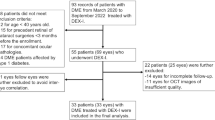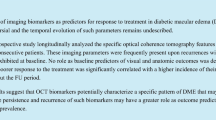Abstract
Purpose
To assess and compare early changes in neuroinflammatory and vascular parameters in diabetic macular edema (DME) with subfoveal neuroretinal detachment (SND) after treatment with intravitreal dexamethasone (DEX-I) and ranibizumab (IVR).
Methods
Thirty-three eyes (33 patients) with treatment naïve DME with SND were retrospectively evaluated at baseline and 2 months after DEX-I (15 eyes) and 1 month after 3 monthly IVR injections (18 eyes). Inclusion criteria were: complete eye examination, good quality OCT and OCT-A images. OCT parameters included: central macular thickness (CMT); number of hyper-reflective retinal spots (HRS) in inner, outer (IR, OR) and full retina; choroidal thickness (CT), extent of disorganization of inner retinal layers (DRIL), outer retina integrity (OR). On OCT-A: foveal avascular zone (FAZ) parameters in the superficial capillary plexus (SCP); cysts area and perfusion density (PD) in SCP and deep capillary plexus (DCP) and flow voids (FV) in choriocapillaris. FAZ was analyzed using ImageJ, perfusion parameters and FV using MATLAB.
Results
BCVA increased equally after both treatments (13.0 ± 10.0 ETDRS letters, p < 0.0001). There was a similar decrease (p < 0.05) in: height of SND, cysts area at SCP, central and mean CT, increase in FAZ perimeter and OR integrity, after both treatments. A greater decrease in DEX-I versus IVR group was found in: CMT (− 38.7% vs. − 22.2%, p = 0.012), HRS number in IR (− 29.2% vs. − 14.0%, p = 0.05) and full retina (− 24.7% vs. − 8.0%, p = 0.03), DRIL extension (− 62.0% vs. − 24%, p = 0.008), cysts area at DCP (− 68.7% vs. − 26.1%, p = 0.03), FAZ-CI (− 19.1% vs. − 8.3%, p = 0.02), PD at DCP (− 27.5% vs. + 4.9%, p = 0.02). FV did not change.
Conclusions
More pronounced changes in specific inflammatory parameters in the inner retina are documented after steroid versus anti-VEGF treatment. These include reduction in HRS number, DRIL extension, CMT, cysts area at DCP. These data may help in further study of noninvasive imaging biomarkers for better evaluation of treatment response.




Similar content being viewed by others
Data availability
The datasets generated during and/or analyzed during the current study are available from the corresponding author on reasonable request.
References
Otani T, Kishi S, Maruyama Y (1999) Patterns of diabetic macular edema with optical coherence tomography. Am J Ophthalmol 127(6):688–693
Gaucher D, Sebah C, Erginay A et al (2008) Optical coherence tomography features during the evolution of serous retinal detachment in patients with diabetic macular edema. Am J Ophthalmol 145(2):289–296
Catier A, Tadayoni R, Paques M et al (2005) Characterization of macular edema from various etiologies by optical coherence tomography. Am J Ophthalmol 140(2):200–206
Sonoda S, Sakamoto T, Yamashita T, Shirasawa M, Otsuka H, Sonoda Y (2014) Retinal morphologic changes and concentrations of cytokines in eyes with diabetic macular edema. Retina 34(4):741–748
Vujosevic S, Torresin T, Berton M, Bini S, Convento E, Midena E (2017) Diabetic macular edema with and without subfoveal neuroretinal detachment: two different morphologic and functional entities. Am J Ophthalmol 181:149–155
Vujosevic S, Simó R (2017) Local and systemic inflammatory biomarkers of diabetic retinopathy: an integrative approach. Invest Ophthalmol Vis Sci 58(6):BIO68–BIO75
Vujosevic S, Bini S, Midena G, Berton M, Pilotto E (2013) Hyperreflective intraretinal spots in diabetics without and with non proliferative diabetic retinopathy: an in vivo study using spectral domain OCT. J Diabetes Res 3:491835
Vujosevic S, Bini S, Torresin T et al (2017) Hyperreflective retinal spots in normal and diabetic eyes: b-scan and en face spectral domain optical coherence tomography evaluation. Retina 37(6):1092–1103
Vujosevic S, Torresin T, Bini S et al (2017) Imaging retinal inflammatory biomarkers after intravitreal steroid and anti VEGF treatment in diabetic macular oedema. Acta Ophthalmol 95(5):464–471
Madeira MH, Boia R, Santos PF, Ambrósio AF, Santiago AR (2017) Contribution of microglia-mediated neuroinflammation to retinal degenerative diseases. Med Inflamm 95(S259):673090
Sohn HJ, Han DH, Kim IT et al (2011) Changes in aqueous concentrations of various cytokines after intravitreal triamcinolone versus bevacizumab for diabetic macular edema. Am J Ophthalmol 152(4):686–694
Vujosevic S, Berton M, Bini S, Casciano M, Cavarzeran F, Midena E (2016) Hyperreflective retinal spots and visual function after anti-vascular endothelial growth factor treatment in center-involving diabetic macular edema. Retina 36(7):1298–1308
Bhanushali D, Anegondi N, Gadde SG et al (2016) Linking retinal microvasculature features with severity of diabetic retinopathy using optical coherence tomography angiography. Invest Ophthalmol Vis Sci 57(9):OCT519–OCT525
Vujosevic S, Muraca A, Gatti V et al (2018) Peripapillary microvascular and neural changes in diabetes mellitus: an OCT-angiography study. IOVS 59(12):5074–5081. https://doi.org/10.1167/iovs.18-24891
Kim K, Kim ES, Yu SY (2018) Optical coherence tomography angiography analysis of foveal microvascular changes and inner retinal layer thinning in patients with diabetes. Br J Ophthalmol 102(9):1226–1231
Ting DSW, Tan GSW, Agrawal R et al (2017) Optical coherence tomographic angiography in type 2 diabetes and diabetic retinopathy. JAMA Ophthalmol 135(4):306–312
Lee J, Moon BG, Cho AR, Yoon YH (2016) Optical coherence tomography angiography of DME and its association with anti-VEGF treatment response. Ophthalmology 123(11):2368–2375
Toto L, D’Aloisio R, Di Nicola M et al (2017) Qualitative and quantitative assessment of vascular changes in diabetic macular edema after dexamethasone implant using optical coherence tomography angiography. Int J Mol Sci 18(6):E1181
Mastropasqua R, D’Aloisio R, Di Nicola M et al (2018) Relationship between aqueous humor cytokine changes and retinal vascular changes after intravitreal aflibercept for diabetic macular edema. Sci Rep 8(1):16548
Vujosevic S, Gatti V, Muraca A et al (2018) Optical coherence tomography angiography changes after subthreshold micropulse yellow laser in diabetic macular edema. Retina. https://doi.org/10.1097/IAE.0000000000002383
de Carlo TE, Chin AT, Joseph T et al (2016) Distinguishing diabetic macular edema from capillary nonperfusion using optical coherence tomography angiography. Ophthalmic Surg Lasers Imaging Retina 47(2):108–114. https://doi.org/10.3928/23258160-20160126-02
Sun JK, Radwan SH, Soliman AZ et al (2015) Neural retinal disorganization as a robust marker of visual acuity in current and resolved diabetic macular edema. Diabetes 64(7):2560–2570
Semmlow JL, Griffel B (2014) Biosignal and biomedical image processing: MATLAB-based applications. CRC Press, New Jersey
Gonzalez RC, Woods RE, Eddins SL (2010) Digital image processing using MATLAB, 2nd edn. Mcgraw Hill, New York
Borrelli E, Balasubramanian S, Triolo G, Barboni P, Sadda SR, Sadun AA (2018) Topographic macular microvascular changes and correlation with visual loss in chronic leber hereditary optic neuropathy. Am J Ophthalmol 192:217–228
Antonetti DA, Klein R, Gardner TW (2012) Diabetic retinopathy. N Engl J Med 366(13):1227–1239
Das A, McGuire PG, Rangasamy S (2015) Diabetic macular edema: pathophysiology and novel therapeutic targets. Ophthalmology 122(7):1375–1394
Vujosevic S, Micera A, Bini S, Berton M, Esposito G, Midena E (2015) Proteome analysis of retinal glia cells related inflammatory cytokines in the aqueous humour of diabetic patients. Acta Ophalmol 94(1):56–64
Yuuki T, Kanda T, Kimura Y et al (2001) Inflammatory cytokines in vitreous fluid and serum of patients with diabetic vitreoretinopathy. J Diabetes Complicat 15(5):257–259
Lee H, Jang H, Choi YA, Kim HC, Chung H (2018) Association between soluble CD14 in the aqueous humor and hyperreflective foci on optical coherence tomography in patients with diabetic macular edema. IOVS 59(2):715–721
Hanisch UK, Kettenmann H (2007) Microglia: active sensor and versatile effector cells in the normal and pathologic brain. Nat Neurosci 10(11):1387–1394
Bonfiglio V, Reibaldi M, Pizzo A et al (2018) Dexamethasone for unresponsive diabetic macular edema: optical coherence tomography biomarkers. Acta Ophthalmol 97(4):540–544. https://doi.org/10.1111/aos.13935
Chatziralli IP, Sergentanis TN, Sivaprasad S (2016) Hyperreflective foci as an independent visual outcome predictor in macular edema due to retinal vascular disease treated with intravitreal Dexamethasone or Ranibizumab. Retina 36(12):2319–2328
Hwang HS, Chae JB, Kim JY, Kim DY (2017) Association between hyperreflective dots on spectral-domain optical coherence tomography in macular edema and response to treatment. IOVS 58(13):5958–5967
Zur D, Iglicki M, Busch C et al (2018) OCT biomarkers as functional outcome predictors in diabetic macular edema treated with Dexamethasone implant. Ophthalmology 125(2):267–275
Page C, Hoffman B, Curtis M, Walker M (1997) Integrated pharmacology. Mosby, London
Reichenbach A, Wurm A, Pannicke T, Iandiev I, Wiedemann P, Bringmann A (2007) Müller cells as players in retinal degeneration and edema. Graefes Arch Clin Exp Ophthalmol 245(5):627–636
Campochiaro PA, Hafiz G, Mir TA et al (2016) Pro-permeability factors in diabetic macular edema; the diabetic macular edema treated with ozurdex trial. Am J Ophthalmol 168:13–23
Bringmann A, Pannicke T, Grosche J et al (2006) Müller cells in the healthy and diseased retina. Progress Retinal Eye Res 25(4):397–424
Uckermann O, Kutzera F, Wolf A et al (2005) The glucocorticoid triamcinolone acetonide inhibits osmotic swelling of retinal glial cells via stimulation of endogenous adenosine signaling. Pharmacol Exp Ther 315(3):1036–1045
Sun JK, Lin MM, Lammer J et al (2014) Disorganization of the retinal inner layers as a predictor of visual acuity in eyes with center-involved diabetic macular edema. JAMA Ophthalmol 132(11):1309–1316
Gallina D, Zelinka CP, Cebulla CM, Fischer AJ (2015) Activation of glucocorticoid receptors in Müller glia is protective to retinal neurons and suppresses microglial reactivity. Exp Neurol 273:114–125
Zur D, Iglicki M, Sala-Puigdollers A et al (2019) Disorganization of retinal inner layers as a biomarker in patients with diabetic macular oedema treated with dexamethasone implant. Acta Ophthalmol. https://doi.org/10.1111/aos.14230
Spaide RF (2016) Retinal vascular cystoid macular edema: review and new theory. Retina 36(10):1823–1842
Spaide RF, Fujimoto JG, Waheed NK, Sadda SR, Staurenghi G (2018) Optical coherence tomography angiography. Prog Ret Eye Res 64:1–55
Funding
This research did not receive any specific grant from funding agencies in the public, commercial or not-for-profit sectors.
Author information
Authors and Affiliations
Contributions
All the authors contributed to the conception or design of the work, the acquisition, analysis and interpretation of data, drafting the work, revising it critically for important intellectual content and gave final approval of the version to be published.
Corresponding author
Ethics declarations
Conflict of interest
Author Stela Vujosevic has received speaker honorarium from Allergan, Bayer, Novartis, Novonordisk and has participated at advisory board of Novartis. Other authors have no conflict of interest in publishing the present work.
Ethical statement
The study adhered to the tenets of the Declaration of Helsinki and was approved by the institutional Ethics Committee (CE 123-2017).
Informed consent
Informed consent was obtained from all patients.
Additional information
Managed By Giuseppe Querques.
Publisher's Note
Springer Nature remains neutral with regard to jurisdictional claims in published maps and institutional affiliations.
Rights and permissions
About this article
Cite this article
Vujosevic, S., Toma, C., Villani, E. et al. Diabetic macular edema with neuroretinal detachment: OCT and OCT-angiography biomarkers of treatment response to anti-VEGF and steroids. Acta Diabetol 57, 287–296 (2020). https://doi.org/10.1007/s00592-019-01424-4
Received:
Accepted:
Published:
Issue Date:
DOI: https://doi.org/10.1007/s00592-019-01424-4




